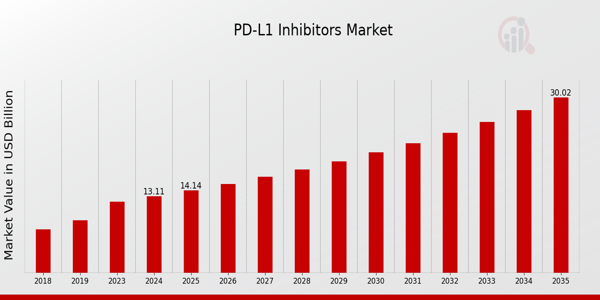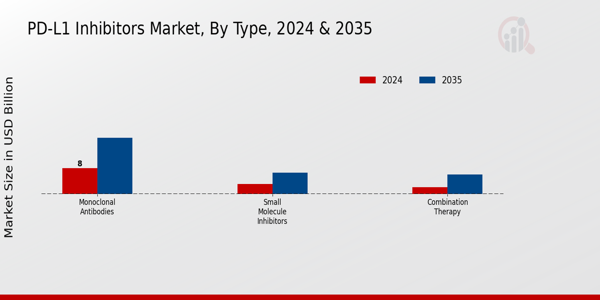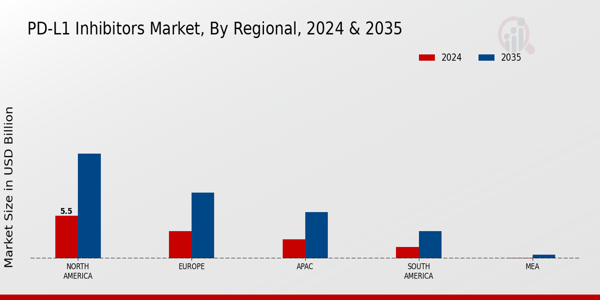PD-L1 Inhibitors Market Overview
As per MRFR analysis, the PD-L1 Inhibitors Market Size was estimated at 12.16 (USD Billion) in 2023.The PD-L1 Inhibitors Market Industry is expected to grow from 13.11(USD Billion) in 2024 to 30 (USD Billion) by 2035. The PD-L1 Inhibitors Market CAGR (growth rate) is expected to be around 7.82% during the forecast period (2025-2035).
Key PD-L1 Inhibitors Market Trends Highlighted
The Global PD-L1 Inhibitors Market is expanding at a rapid pace, primarily due to the increasing incidence of cancer and the rising prevalence of immune-related disorders. Pharmaceutical companies have been motivated to invest in the research and development of PD-L1 inhibitors in response to the demand for innovative therapies, which has opened up new treatment options. Furthermore, the recent success of clinical trials has increased the confidence in these therapies, thereby fostering their wider adoption among healthcare providers worldwide.
The increasing emphasis on personalized medicine is another significant market driver, as it enables the development of more personalized treatment approaches that are based on the genetic composition and specific condition of a patient, resulting in improved outcomes. In addition to oncology, there is potential for the expansion of PD-L1 inhibitor indications in other therapeutic areas, including infectious diseases and autoimmune diseases.
Opportunities for exploration include these areas. The global market presence and availability of PD-L1 inhibitors are expected to be enhanced by the increase in collaborations between biopharmaceutical companies and research institutions, which is expected to accelerate innovation in this field. Furthermore, the market can be further stimulated by regulatory support from agencies like the FDA and EMA, which provide expedited review pathways for prospective therapies. In recent years, there has been a trend toward a collaborative approach to combination therapies, in which PD-L1 inhibitors are being evaluated in conjunction with other therapeutic modalities, potentially enhancing their efficacy.
The utilization of biomarkers for patient selection is gathering momentum, which has the potential to result in more effective treatment strategies. The global healthcare landscape is increasingly emphasizing affordability and accessibility, which is fostering initiatives to ensure that innovative treatments are accessible to a wide range of patient populations.

Source: Primary Research, Secondary Research, MRFR Database and Analyst Review
PD-L1 Inhibitors Market Drivers
Increasing Incidence of Cancers Globally
The rising incidence of various cancer types globally is a significant driver for the Global PD-L1 Inhibitors Market Industry. According to the World Health Organization, cancer cases are projected to increase globally by about 47% from 2020 to 2040, reaching an estimated 29.5 million new cases annually. This increase is partly due to aging populations and lifestyle changes. As more individuals are diagnosed with cancer, the demand for innovative therapeutic options, particularly PD-L1 inhibitors, is expected to rise.
Established organizations such as the American Cancer Society play a crucial role in cancer research and awareness, significantly influencing treatment protocols and market trends. Furthermore, advancements in Research and Development initiatives in this sector are vital as pharmaceutical companies strive to improve the efficacy of PD-L1 inhibitors, thus fostering growth within the Global PD-L1 Inhibitors Market.
Technological Advancements in Cancer Therapeutics
Technological advancements in cancer therapeutics have been transformative for the Global PD-L1 Inhibitors Market Industry. Innovations such as biomarker identification and personalized medicine have enhanced the development of targeted therapies, including PD-L1 inhibitors. The National Cancer Institute reports that advancements in genomic profiling have enabled more precise treatment strategies, which directly benefit patients and increase market growth.
With renowned institutions like the National Institutes of Health leading in Research and Development initiatives, the strategic integration of new technologies in oncology is anticipated to propel the proliferation of PD-L1 inhibitors.
Supportive Government Policies and Funding
Supportive government policies and increased funding for cancer research are pivotal in driving the Global PD-L1 Inhibitors Market Industry. Countries such as the United States have significantly expanded their budgets for cancer research initiatives, highlighted by the Cancer Moonshot program aiming to accelerate cancer research and improve patient outcomes. These policies not only foster innovation in Research and Development but also enhance the potential for new PD-L1 inhibitors to enter the market.
The collaboration between government agencies and private pharmaceutical companies underscores the essential role of such initiatives in addressing cancer treatment needs, ultimately supporting market expansion.
Growing Demand for Immunotherapy Treatments
The rising demand for immunotherapy treatments marks a vital driving factor for the Global PD-L1 Inhibitors Market Industry. With patients and healthcare providers increasingly recognizing the effectiveness of immunotherapies in combatting cancer, the global market has seen significant growth. A report from the American Society of Clinical Oncology indicates that around 40% of new cancer treatments are immunotherapies, allowing for better patient outcomes with fewer side effects compared to traditional therapies.
Leading pharmaceutical companies are focusing on developing competitive PD-L1 inhibitors to meet this demand, reflecting a broader shift towards immunotherapy in cancer treatment, thus propelling the Global PD-L1 Inhibitors Market forward.
PD-L1 Inhibitors Market Segment Insights
PD-L1 Inhibitors Market Type Insights
Within the PD-L1 Inhibitors Market landscape, the Type segment is crucial and comprises three primary categories: Monoclonal Antibodies, Small Molecule Inhibitors, and Combination Therapy. The Monoclonal Antibodies category holds the majority market share, valued at 8.0 USD Billion in 2024 and anticipated to reach 17.4 USD Billion by 2035, primarily due to their targeted mechanism of action and effectiveness in treating various cancers such as lung and melanoma.
These therapies leverage the body’s immune response to fight tumors, hence their predominance in the market. Small Molecule Inhibitors, representing another important category, are valued at 3.0 USD Billion in 2024 and projected to increase to 6.6 USD Billion by 2035.
Although smaller in comparison to Monoclonal Antibodies, their emerging role in bridging therapeutic gaps makes them a significant part of the overall treatment paradigm, expanding access to therapies for different patient populations. Combination Therapy, valued at 2.11 USD Billion in 2024 and expected to grow to 6.0 USD Billion by 2035, is gaining traction as it facilitates synergetic effects between multiple treatment modalities, which improves patient outcomes while enhancing the efficacy of individual treatments.
The rise of these combined approaches is prompting collaborative research initiatives and enabling more nuanced treatment strategies. Innovations in drug development are driving the growth in the Global PD-L1 Inhibitors Market, increasing the incidence of cancer worldwide, and the need for more effective treatment options, positioning it as a vital segment in the Global PD-L1 Inhibitors Market landscape. Overall, the Type segment reflects the dynamic and multifaceted nature of the Global PD-L1 Inhibitors Market, revealing opportunities and challenges that present themselves in the pursuit of innovative cancer therapies.

Source: Primary Research, Secondary Research, MRFR Database and Analyst Review
PD-L1 Inhibitors Market Indication Insights
The Global PD-L1 Inhibitors Market is set to garner significant attention due to its wide-ranging applications across various indications. This market segment encompasses critical therapeutic areas, including Non-Small Cell Lung Cancer, Breast Cancer, Bladder Cancer, Hepatocellular Carcinoma, and Melanoma, each contributing uniquely to the overall landscape. Non-small cell Lung Cancer remains one of the most prevalent indications, significantly driving research and development investments.
Breast Cancer has also become a focal point, given its high incidence rate globally, prompting a continual need for innovative therapies.
Bladder Cancer and Hepatocellular Carcinoma are gaining ground due to rising cases and the demand for effective treatment options. At the same time, Melanoma showcases robust growth owing to increasing awareness and screening programs. The Global PD-L1 Inhibitors Market data reflects a surge in demand for targeted therapies in these areas, highlighting their significance in the treatment landscape. As the market evolves, developments in these indication areas are expected to play a pivotal role in addressing unmet medical needs and improving patient health outcomes.
PD-L1 Inhibitors Market Administration Route Insights
The Global PD-L1 Inhibitors Market, valued at 13.11 USD billion in 2024, exhibits a considerable focus on various Administration Routes, which are crucial for the therapeutic delivery of PD-L1 inhibitors. These routes, including Intravenous, Subcutaneous, and Oral administration, are designed to optimize patient convenience and therapeutic efficacy. Intravenous administration is often preferred for its rapid action and bioavailability, enabling healthcare providers to manage complex cases effectively. Subcutaneous routes are gaining traction due to their ease of use, which allows patients to receive treatment in outpatient settings.
Oral administration, while less common, presents an opportunity for self-administration, enhancing patient adherence to therapy. The market continues to evolve, driven by technological advancements and increasing acceptance of these administration methods among healthcare providers and patients. Furthermore, the market growth is propelled by rising cancer incidence globally, highlighting the need for effective treatment options that are conveniently administered. The Global PD-L1 Inhibitors Market statistics reveal how these diverse administration routes significantly contribute to the overall market dynamics, catering to differing patient needs and preferences across the globe.
PD-L1 Inhibitors Market End User Insights
The Global PD-L1 Inhibitors Market exhibits significant growth potential within the End User segment, which comprises Hospitals, Oncology Clinics, and Research Laboratories. Hospitals play a vital role in providing comprehensive cancer care and access to advanced treatment options, capturing a substantial share of the market. Oncology Clinics are also critical, as they specialize in cancer treatment and offer personalized therapies, which enhance patient outcomes and drive the market further.
Research Laboratories significantly contribute to innovation in the PD-L1 inhibitors space, focusing on clinical trials and R efforts that pave the way for new therapies and better understanding of the drug's efficacy and safety.
As the Global PD-L1 Inhibitors Market expands, the integration of these End User segments is pivotal in enhancing treatment accessibility and advancements in cancer therapies. Increasing incidence of cancer globally and continuous advancements in healthcare technologies are some key trends driving market growth, while regulatory challenges and high treatment costs present notable obstacles. The ongoing evolution of treatment modalities within the industry presents ample opportunities for the end-user segments to thrive.
PD-L1 Inhibitors Market Regional Insights
The Global PD-L1 Inhibitors Market exhibits substantial regional variations, showcasing a robust growth trajectory across its distinct segments. In 2024, North America leads with a valuation of 5.5 USD Billion, accounting for a majority holding in the overall market, driven by advanced healthcare infrastructure and high rates of oncology investments. Europe follows with a valuation of 3.5 USD Billion, reflecting its strong regulatory frameworks promoting innovative therapeutics. The Asia-Pacific (APAC) region, valued at 2.5 USD Billion in 2024, is gaining traction due to increasing cancer prevalence and a rising patient pool, presenting significant opportunities for industry players.
South America, holding a valuation of 1.5 USD Billion, is progressively establishing itself as a noteworthy market, buoyed by improving healthcare access and affordability. Lastly, the Middle East and Africa (MEA) represent the smallest segment with a value of 0.11 USD Billion. Yet, it is anticipated to grow as healthcare systems develop and awareness about immunotherapy advances. Overall, the Global PD-L1 Inhibitors Market is strategically influenced by these regional dynamics, shaping market growth and opportunities within the industry.

Source: Primary Research, Secondary Research, MRFR Database and Analyst Review
PD-L1 Inhibitors Market Key Players and Competitive Insights
The Global PD-L1 Inhibitors Market showcases a dynamic landscape characterized by intense competition and innovation. As the pharmaceutical industry seeks to advance immunotherapy treatments, the focus on PD-L1 inhibitors has gained significant momentum due to their effectiveness in treating various cancers. The market has seen a surge in the development of these therapeutics, driven by increasing healthcare expenditures, growing prevalence of cancer, and enhanced understanding of immune checkpoint mechanisms.
Competitive insights into this market reveal a mix of well-established players and emerging companies, all of which are vying for dominance through strategic partnerships, research collaborations, and extensive clinical trials aimed at expanding the therapeutic applications of PD-L1 inhibitors.
Takeda has positioned itself as a noteworthy player in the Global PD-L1 Inhibitors Market, leveraging its extensive research capabilities and strong financial backing to enhance its product pipeline. The company's commitment to innovation is evident in its investment in cutting-edge clinical trials and collaborations that aim to better the understanding of PD-L1 inhibition in oncology. Takeda's strengths lie in its robust global presence, allowing it to tap into diverse markets and adapt its strategies based on regional needs. This adaptability not only enhances its competitive edge but also illustrates its dedication to bringing advanced treatment options to patients worldwide.
The company’s proactive approach to forming strategic alliances has further bolstered its position in the market, ensuring a steady flow of new therapeutic options to address unmet clinical needs.Merck and Co has established a strong foothold in the Global PD-L1 Inhibitors Market, recognized for its innovative approaches to immunotherapy.
The company’s flagship product set includes several PD-L1 inhibitors that have gained regulatory approval for multiple cancer indications, thereby enhancing its market presence. Merck and Co's strengths lie in its extensive research and development pipeline backed by significant investments, which facilitate the exploration of novel drug candidates and combinations.
Additionally, the company has engaged in strategic mergers and acquisitions to consolidate its position in the market, which not only expands its product offerings but also enhances its technological capabilities. This forward-thinking strategy, alongside its unwavering commitment to addressing the complexities of cancer treatment, positions Merck and Co. as a formidable competitor in the global landscape of PD-L1 inhibitors, making substantial contributions to advancing patient care in oncology.
Key Companies in the PD-L1 Inhibitors Market Include
- Takeda
- Merck and Co
- Pfizer
- Ionis Pharmaceuticals
- Roche
- AbbVie
- Eli Lilly
- Bristol Myers Squibb
- Seattle Genetics
- Novartis
- Regeneron Pharmaceuticals
- Bayer
- AstraZeneca
- GlaxoSmithKline
- Amgen
PD-L1 Inhibitors Market Industry Developments
Recent developments in the Global PD-L1 Inhibitors Market have shown a significant upward trend in investment and research efforts, mainly led by prominent companies such as Merck and Co., Bristol Myers Squibb, and Roche. Merck and Co. recently announced advancements in their PD-L1 inhibitor portfolio, particularly in treatments for various cancers, showcasing enhancements in efficacy and safety profiles as of October 2023. Additionally, Roche's collaboration with Seattle Genetics aims to expand its therapeutic offerings, emphasizing combined therapies involving PD-L1 inhibitors. In terms of mergers and acquisitions, AbbVie acquired the rights to a PD-L1 inhibitor from a smaller biotech firm in July 2023, strategically enhancing its oncology lineup.
The valuation of companies, including AstraZeneca and Pfizer, has notably increased, with AstraZeneca reporting a 15% rise in market share due to their innovative PD-L1 therapies. The market has experienced a continuous growth trajectory over the past 2-3 years, and regulatory approvals for new treatments have been expedited, contributing to an increasingly competitive landscape within the Global PD-L1 Inhibitors Market. This dynamic environment is reflective of the escalating demand for effective cancer therapies worldwide.
PD-L1 Inhibitors Market Segmentation Insights
PD-L1 Inhibitors Market Type Outlook
- Monoclonal Antibodies
- Small Molecule Inhibitors
- Combination Therapy
PD-L1 Inhibitors Market Indication Outlook
- Non-Small Cell Lung Cancer
- Breast Cancer
- Bladder Cancer
- Hepatocellular Carcinoma
- Melanoma
PD-L1 Inhibitors Market Administration Route Outlook
- Intravenous
- Subcutaneous
- Oral
PD-L1 Inhibitors Market End User Outlook
- Hospitals
- Oncology Clinics
- Research Laboratories
PD-L1 Inhibitors Market Regional Outlook
- North America
- Europe
- South America
- Asia Pacific
- Middle East and Africa
| Report Attribute/Metric Source: |
Details |
| MARKET SIZE 2023 |
12.16(USD Billion) |
| MARKET SIZE 2024 |
13.11(USD Billion) |
| MARKET SIZE 2035 |
30.0(USD Billion) |
| COMPOUND ANNUAL GROWTH RATE (CAGR) |
7.82% (2025 - 2035) |
| REPORT COVERAGE |
Revenue Forecast, Competitive Landscape, Growth Factors, and Trends |
| BASE YEAR |
2024 |
| MARKET FORECAST PERIOD |
2025 - 2035 |
| HISTORICAL DATA |
2019 - 2024 |
| MARKET FORECAST UNITS |
USD Billion |
| KEY COMPANIES PROFILED |
Takeda, Merck and Co, Pfizer, Ionis Pharmaceuticals, Roche, AbbVie, Eli Lilly, Bristol Myers Squibb, Seattle Genetics, Novartis, Regeneron Pharmaceuticals, Bayer, AstraZeneca, GlaxoSmithKline, Amgen |
| SEGMENTS COVERED |
Type, Indication, Administration Route, End User, Regional |
| KEY MARKET OPPORTUNITIES |
Increasing cancer prevalence, Rising demand for immunotherapy, Expanding research on combination therapies, Growth in emerging markets, Advancements in personalized medicine |
| KEY MARKET DYNAMICS |
Rising cancer prevalence, Increasing R&D investments, Expanding product pipeline, Regulatory approvals and market access, Growing awareness and adoption |
| COUNTRIES COVERED |
North America, Europe, APAC, South America, MEA |
Frequently Asked Questions (FAQ) :
The Global PD-L1 Inhibitors Market is expected to be valued at 13.11 USD Billion in 2024.
By 2035, the Global PD-L1 Inhibitors Market is expected to reach a value of 30.0 USD Billion.
The expected CAGR for the Global PD-L1 Inhibitors Market from 2025 to 2035 is 7.82%.
North America is anticipated to dominate the Global PD-L1 Inhibitors Market with a valuation of 5.5 USD Billion in 2024.
The market for PD-L1 Inhibitors in Europe is valued at 3.5 USD Billion in 2024.
The market size for Monoclonal Antibodies under the Global PD-L1 Inhibitors Market is valued at 8.0 USD Billion in 2024.
By 2035, the market value for Combination Therapy in the Global PD-L1 Inhibitors Market is projected to reach 6.0 USD Billion.
Significant players in the Global PD-L1 Inhibitors Market include companies such as Takeda, Merck & Co, and Pfizer.
The APAC region is expected to be valued at 2.5 USD Billion in the Global PD-L1 Inhibitors Market in 2024.
Emerging competition and regulatory challenges are potential difficulties facing the Global PD-L1 Inhibitors Market.

















